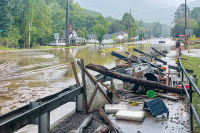Life on the rock
Workers on the rockslide slope are laboring around the clock. There’s a day crew and a night crew, ranging from 15 to 25 men per shift. They labor for 10 hours at a stretch on the side of a steep, towering rock face.
“If you need anything you take it up with you. They don’t come back down,” said Mike Patton, the lead DOT inspector on the site.
That goes not just for food, but using the bathroom, too.
“Once you get up there it is every man for himself,” Patton said.
During the first two months, when work primarily focused on busting up and hauling off the major pile of boulders at the base of the slide, there were dozens of equipment operators and dump truck drivers coming and going to the site. Workers would often call in a massive order of hamburgers to a diner in Hartford, Tenn., and a woman who worked there would deliver them. One entrepreneuer set up a Philly Cheese Steak concession stand near the worksite and became known as Hotdog Willie. He even made a turkey dinner for workers laboring on Thanksgiving Day.
But once the pile was carted away and work shifted to the mountainside overhead, there weren’t enough workers on the ground to support the hot lunch spot and he closed up shop, although his stand is still parked at the staging area.
Related Items
Now, the remaining ground crews, as well as those on the slope, must pack sandwiches and sundry snacks to sustain themselves during the long work days and cold, dark nights in the remote Pigeon River Gorge.
Staying warm is a challenge in the shadow of the tall, narrow walls of the gorge, which block the sun for all but the middle part of the day. Shane Cook, a worker for the main contractor on the job, Phillips and Jordan, knows exactly what time the sun crests the ridge and the first patch of pavement where it hits.
“About 9 o’clock in the morning it comes across that ridge and about 2:30 it goes behind that one, so you don’t get but about 5 hours,” Cook said.
Ground crews and inspectors sometimes pack into the contractor’s trailers for quick warm ups during the day, but mostly resort to climbing in and out of their trucks and blasting the heater to dethaw. Needless to say, they call come to work with a full tank of gas. Some on the night shift bring an extra five gallon gas can.
They wear extra pants, two pairs of gloves, fleece caps with ear flaps under their hardhats and bring an extra pair of socks to change into in case the ones they have get wet.
But those high above on the rock have no truck to climb into to stay warm and can’t work when too encumberd by layers. During the worst of Janurary’s extreme cold, when lows dipped into single digits repeatedly night after night, work was suspended.









